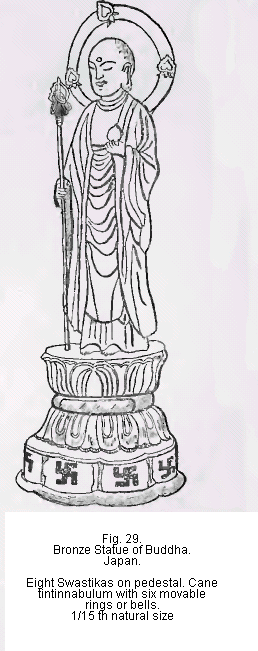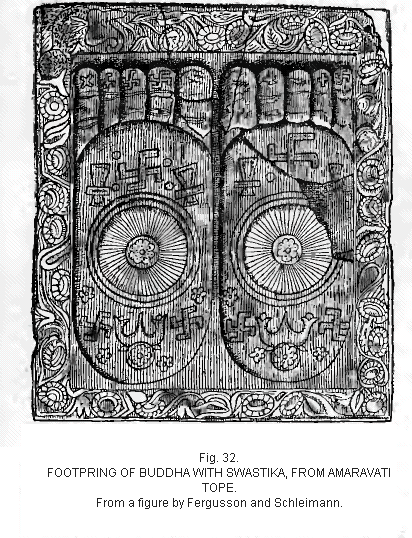

The Swastika
Dispersion of the Swastika
Mr. William Woodvill Rockhill, (1) speaking of the fair at Kumbum, says:
I found there a number of Lh’asa Tibetans (they call them gopa here) Selling pulo, beads of various colors, saffron, medicines, peacock feathers, incense sticks, etc. I had a talk with these traders, several of whom I had met here before in 1889. * * * One of them had a Swastika (yung-drung) tattooed on his hand, and I learned from this man that this is not an uncommon mode of ornamentation in his country.
Count D’Alviella says that the Swastika is continued among the Buddhists of Tibet; that the women ornament their petticoats with it, and that it is also placed upon the breasts of their dead. (2)
He also reports (3) a Buddhist statue at the Musée Guimet with Swastikas about the base. He does not state to what country it belongs, so the author has no means to determining if it is the same statue as is represented in
 fig. 29.
fig. 29.Burnouf (4) says approvingly of the Swastika:
Christian archaeologists believe this was the most ancient sign of the cross. * * * It was used among the Brahmins from all antiquity. (Voyez mot “Swastika” dans notre dictionaire sanskrit.) Swastika, or Swasta, in India corresponds to “benediction” among Christians.
The same author, in his translation of the “Lotus de la Bonne Loi,” one of the nine Dharmas or Canonical books of the Buddhists of the North, of 280 pages, adds an appendix of his own writing of 583 pages; and in one (No.8) devoted to an enumeration and description of the sixty-five figures traced on the footprint of Çakya (fig.32) commences as follow:
1. Swastikaya: This is the familiar mystic figure of many Indian sects, represented thus,
* * * The Sign of the Swastika was not less known to the Brahmins than to the Buddhists. “Ramayana,” Vol. II, p. 348, ed. Gor., Chap. XCVII, st. 17, tells of vessels on the sea bearing this sign of fortune. This mark, of which the name and usage are certainly ancient, because it is found on the oldest Buddhist medals, may have been used as frequently among the Brahmins as among the Buddhists. Most of the inscriptions on the Buddhist caverns in western India are either preceded or followed by the holy (sacramentelle) sign of the Swastika. It appears less common on the Brahmin monuments.
 Mr W. Crooke (Bengal Civil
Service, director of Eth. Survey, North-west Provinces and Oudh), says:
(5)
Mr W. Crooke (Bengal Civil
Service, director of Eth. Survey, North-west Provinces and Oudh), says:
(5)The mystical emblem of the Swastika, which appears to represent the sun in his journey through the heavens, is of constant occurrence. The trader paints it on the flyleaf of his ledger, he who has young children or animals liable to the evil eye makes a representation of it on the wall beside his doorpost. It holds first place among the lucky marks of the Jainas. It is drawn on the shaven heads of children on the marriage day in Gujarat. A red circle with Swastika in the center is depicted on the place where the family gods are kept (Campbell, Notes, p. 70). In the Meerut division the worshiper of the village god Bhumiya constructs a rude model of it in the shrine by fixing up two crossed straws with a daub of plaster. It often occurs in folklore. In the drama of the Toy Cart the thief hesitates whether he shall make a hole in the wall of Charudatt’s house in the form of a Swastika or of a water jar (Manning, Ancient India, II, 160).
Village shrines– The outside (of the shrines) is often covered with rude representations of the mystical Swastika.
On page 250 he continues thus:
Charms.– The bazar merchant writes the words “Ram Ram” over his door, or makes an image of Genesa, the god of luck, or draws the mystical Swastika. The jand tree is reverenced as sacred by Khattris and Brahmins to avoid the evil eye in children. The child is brought at 3 years of age before a jand tree; a bough is cut with a sickle and planted at the foot of the tree. A Swastika symbol is made before it with the rice flour and sugar brought as an offering to the tree. Threads of string, used by women to tie up their hair, are cut in lengths and some deposited on the Swastika.
Mr. Virchand R. Gandhi, a Hindu and Jain disciple from Bombay, India, a delegate to the World’s Parliament of Religions at Chicago in 1893, remained for sometime in Washington, D. C., proselyting among Christians. He is a cultivated gentleman, devoted to the spread of his religion. I asked his advice and assistance, which he kindly gave, supervising my manuscript for the Swastika in the extreme Orient, and furnishing me the following additional information relative to the Swastika in India, and especially among the Jains:
The Swastika is misinterpreted by so-called Western expounders of our ancient Jain philosophy. The original idea was very high, but later on some persons thought the cross represented only the combination of the male and the female principles. While we are on this physical plane and our propensities on the material line, we think it necessary to unite those (sexual) principles for our spiritual growth. On
ENDNOTES:
1. “Diary of a Journey through Mongolia and Tibet in 1891-93,” p. 67. [Back]
2. “La Migration des Symboles,” p.55, citing note I, Jouru, Asiatique, 2nd série, iv, p.245, and Pallas, “Sanmlungen historischer Naehrichten liber die mongolisheu Völkerschaften,: I, p277. [Back]
3. Ibid., p. 55. [Back]
4. “Des Sciences et Religion,” p. 256. [Back]
5. “Introduction to Popular Religion and Folk Lore of North India.” p. 58. [Back]
<< Previous Page Next Page >>
© 2004-2007 Northvegr.
Most of the material on this site is in the public domain. However, many people have worked very hard to bring these texts to you so if you do use the work, we would appreciate it if you could give credit to both the Northvegr site and to the individuals who worked to bring you these texts. A small number of texts are copyrighted and cannot be used without the author's permission. Any text that is copyrighted will have a clear notation of such on the main index page for that text. Inquiries can be sent to info@northvegr.org. Northvegr™ and the Northvegr symbol are trademarks and service marks of the Northvegr Foundation.

|